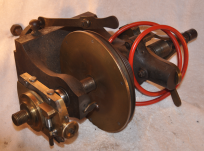SpeechlessCalm
Plastic
- Joined
- Mar 29, 2023
I hope it's not too far 'out of scope' to post this enquiry here. It's totally not a 'today' type of issue, but I figure (and hope) there's likely to be folk with the depth of knowledge needed.
I am trying to identify the thread on the shoulder segment of the main headstock spindle/quill of my old lathe, so I can have an adapter built to switch an eccentric chuck assembly from this lathe to a slightly moremodern lathe.
The lathe in question is old, like mid-1800s. It's treadle powered, notwithstanding the electric motor and belt drive that I have fitted to it. Family history has that the lathe itself was handbuilt and it has no identifying marks at all on it, just stamped numbers on elements to identify sizes and gradations or screw locations. It is likely that it was built in England, although Australia is a possibility. It's also possible it is a no-name knock-off ... although some of the fittings are quite exquisite. I'm not seeking to 'identify' the lathe itself, just this one thread.
I have numerous chucks and other fittings that screw nicely onto the spindle, but only the one 'male' example ... the spindle itself.
Using a ruler I get the spindle thread as 1" diameter, and approximately 9.5tpi (7 turns in 3/4 of an inch) - see top-left and middle-left images in attachment. Using a metric rule I see 14mm for 5 turns, FWIW (top right image). The closest thread 'comb' I have (and I do not have an extensive collection) is marked 9G 7/8" and it is not a perfect fit (middle-right image).
The lathe itself has a thread chasing assembly (unusual design where the headstock spindle itself moved) built into the back-end of the headstock (bottom image). That assembly has a threading option that matches the shoulder thread, and it is marked as '3'.
I am trying to identify the thread on the shoulder segment of the main headstock spindle/quill of my old lathe, so I can have an adapter built to switch an eccentric chuck assembly from this lathe to a slightly moremodern lathe.
The lathe in question is old, like mid-1800s. It's treadle powered, notwithstanding the electric motor and belt drive that I have fitted to it. Family history has that the lathe itself was handbuilt and it has no identifying marks at all on it, just stamped numbers on elements to identify sizes and gradations or screw locations. It is likely that it was built in England, although Australia is a possibility. It's also possible it is a no-name knock-off ... although some of the fittings are quite exquisite. I'm not seeking to 'identify' the lathe itself, just this one thread.
I have numerous chucks and other fittings that screw nicely onto the spindle, but only the one 'male' example ... the spindle itself.
Using a ruler I get the spindle thread as 1" diameter, and approximately 9.5tpi (7 turns in 3/4 of an inch) - see top-left and middle-left images in attachment. Using a metric rule I see 14mm for 5 turns, FWIW (top right image). The closest thread 'comb' I have (and I do not have an extensive collection) is marked 9G 7/8" and it is not a perfect fit (middle-right image).
The lathe itself has a thread chasing assembly (unusual design where the headstock spindle itself moved) built into the back-end of the headstock (bottom image). That assembly has a threading option that matches the shoulder thread, and it is marked as '3'.



